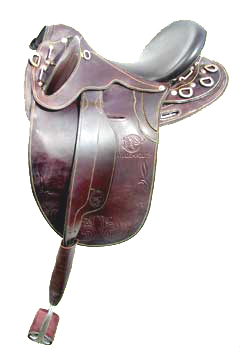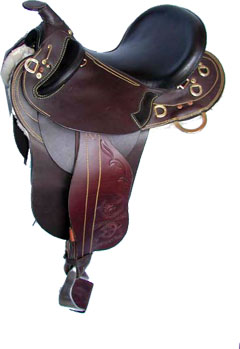
What
started in the 1980's as a fad after the popularity of the movie
The Man From Snowy River has persevered into the 90's.
The Australian stock saddle with its distinct knee rolls and
lack of saddle horn has proven itself to be a contender not only
in the Outback, but in the trails in the US of A, too.
This
import from Australia has proven to be as popular with Americans
as their Australian Shepherds and Heelers. Because the
tack is good looking, tough and functional, it has captured not
only the imagination of riders, but their respect as well.
Those who ride these saddles are swear by their comfort and
durability. In fact, it is very easy in America to find a
pickup with a Australian heeler dog in it attached to trailer
with a mule or horse with an Aussie saddle heading for the trail
head.
Just
like its distinctive look, the Australian stock saddle has
a atypical history. Since Australia was designated as a
penal colony by the English, it was settle over two hundred
years ago by convicts and prison guards sent to control them.
This sturdy saddle was, in fact, designed for rugged, unexplored
territory to keep the convicts one jump ahead of the police who
were in hot pursuit.
The
fugitive criminals often stole horse and saddle during their
escape. The hunt saddles brought from England fell far
short of providing stability and security for the fleeing
outlaws. Consequently, the saddles were soon modified to
include the hunks of leather sewn which evolved into the knee
pad or Apoley for
which the Aussie saddles are known. Adopting the name A
convict saddles, these saddles eventually
were made with a deeper seats and higher cantles to add even
more security for the rider. Eventually, even rear thigh
pads were added.
As the
convict saddle took on its character and became more accepted,
saddle makers began to consider the effect of the saddle on the
horse. Thick pads covered in serge to sweep away sweat
from the horses body became the norm. An air chamber was
designed to keep the saddle from touching the back and soreing
the horse. Eventually, the air chamber became wider and
deeper. Consequently, no portion of the saddle rested on
the withers or the spine.
So
evolved the Australian stock saddle which was used by ranchers
and trainers.
With
the popularity of the stock saddle in the U.S., modifications
needed to be made for both the American horses and the American
riders. Australian horses were Thoroughbred types, thinner
and in shape. American horses were of wider breeds, better fed
and less in shape. Consequently, saddles made for export
to the U.S. were designed with wider trees to accommodate the
less used and better fed horses.
In
addition, the rear thigh pads were not popular. They
tended to leave less room for the better fed and less in shape
American riders. So they were dropped on most saddles
destined for the United States. These rear thigh pads are
still optional and certainly keep the rider in place during
trail riding and bucking sessions.
Of
course, the most noticeable difference in the stock saddle from
the western saddle is the lack of the horn. When working
cattle in Australia, the stockmen do not rope the cattle. They work
them with whips and, therefore, have no need for a horn around
which to dally a rope. Americans, however, couldn't seem
to do without the horn to grab onto in a panic situation.
The horn provided a visible security and they wanted it at least
as an option. Consequently, saddles made for export were
made available with a horn. Although the horn is not
strong enough for dallying a calf and warned against, it still
can hold a horn bag for trail riding and be available as a
handle in case of loss of security in a panic.
Australia, the stockmen do not rope the cattle. They work
them with whips and, therefore, have no need for a horn around
which to dally a rope. Americans, however, couldn't seem
to do without the horn to grab onto in a panic situation.
The horn provided a visible security and they wanted it at least
as an option. Consequently, saddles made for export were
made available with a horn. Although the horn is not
strong enough for dallying a calf and warned against, it still
can hold a horn bag for trail riding and be available as a
handle in case of loss of security in a panic.
For
those who opt not to have a horn, a A
monkey
grip
can be used. This is a strap attached to the pommel of the
saddle. It can be grabbed for added security.
The
Australian Stock Saddle became popular in the U.S. for trail
riding for a number of reasons. First, its security made
it attractive to those who rode rough terrain. Second, it
found favor with women riders because it is light and more
narrow to sit. It also became a popular saddle for
endurance riders. Even ranchers and trainers have given it
a try and like it.
Of
course, there are draw backs to the Aussie saddle. One,
obviously, is roping. Those styles without a horn are
useless and those with a horn only have horns that decorative.
Usually, this warning is stamped on the saddle itself to keep
someone from having a bad accident.
Another area in which this saddle falls far short and so may the
rider, is in English jumping. While it is certainly fine
for jumping creeks and small logs, it would interfere with the
rider in jumping great heights. It certainly would be a
disaster in Equitation over fences.
The
trees of stock saddles can be made of fiberglass with a steel
gullet or steel reinforced wood. Of course, custom fit
trees are available.
In
fitting the Australian saddle, view the saddle from the front of
the mule. The padding should be in full contact with the
mules back and the gullet must clear the mules withers.
Stuffing in these panels can be of many different materials from
natural to synthetic. True diehards, however, prefer
cowhair or horsehair for superior fit.
Pay
attention to the position of the knee pad. The more angled
back, the more security it provides the rider. These take little
getting use to and generally never touch the leg unless needed.
In
addition, most stock saddles are equipped with attachments for
cruppers. And, the traditional stirrup is the oxbow type.
In
terms of fitting the rider, this saddle should bit snugly, not
too tight and too roomy. The rider's height and weight also
influence the correct fit.
These saddles are not accepted in the show ring,
but you can't beat them on the trail.